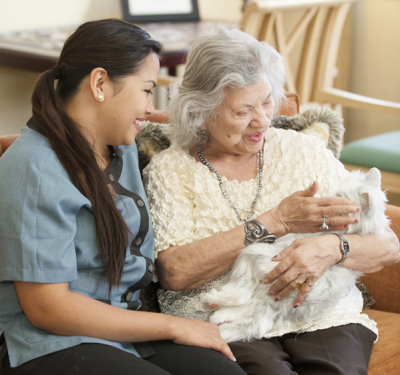
We’ve known the benefits of pet therapy for decades; however, care settings may be concerned about safety issues and commitment to maintaining an animal on site. Research on therapeutic assistive robotic pets has emerged in the last decade. Robotic companion pets offer an alternative to, or complement traditional pet therapy and have been shown to have similar positive effects.
Robotic companion pets provide a useful alternative when live animals aren’t feasible. Live pets in care settings bring both benefits and risks. Often the risk prohibits live pets or limits them to only occasional visits. Robotic companion pets have minimal risk associated with them, and research has shown that people with dementia experience similar benefits as interacting with live animals. Used on-demand, robotic pets eliminates scheduling issues. As a result, elders enjoy the benefit of a relationship with a Pet as they desire it.
Benefits of Companion Pets:
These beneficial effects were reported in research studies and observations described by care partners.
Increased Interaction with Others and the Surroundings
- Increased social interaction between elders when sharing time with the Pet.
- Some showed greater interest in what was happening in their surroundings.
- The conversation became more spontaneous.
Connection to Memories
- The Pet stimulated sharing memories of the experience with family pets.
Increased Feelings of Self Worth
- The Pet seemed to restore a sense of purpose while caring for it through brushing, petting, and talking to it.
Decreased Anxiety and Agitation
- Interacting with the Pet seemed to ease anxiety and, in turn, lessened challenging behavior.
Improved Mood
- Exhibited playfulness.
- Facial expression brightened with a smile.
Physical Response
- Movement increased while reaching for, holding, and petting the Pet.
- Elders responded to the tactile (sense of touch) stimulation of the Pet.
- One study found oxygen saturation increased while interacting with the Pet, apparently from increased motor activity, talking and otherwise interacting with the Pet, resulting in increased respiration.
Reduced Care Partner Burden
- Some elders cooperate more easily during routine ADL following interaction with the Pet.
- Many enjoy lingering positive effects following interaction with the Pet and can participate in other activities with more considerable attention.
With Alzheimer’s disease and other forms of dementia on the rise worldwide, there’s a greater need for creative approaches to improve well-being and ease distressed behavior so typical in people with dementia. Robotic companion pets could play an essential role in the emotional and social wellbeing of people living with dementia in nursing homes, home care, day memory support, hospitals, and hospice settings.
Ann Catlin, OTR, LMT: For twenty years, Ann led in the field of skilled touch in eldercare and hospice. She has nearly forty years’ clinical experience as an occupational and massage therapist. She created Age-u-cate’s Compassionate Touch program and serves as a Master Trainer and training consultant.